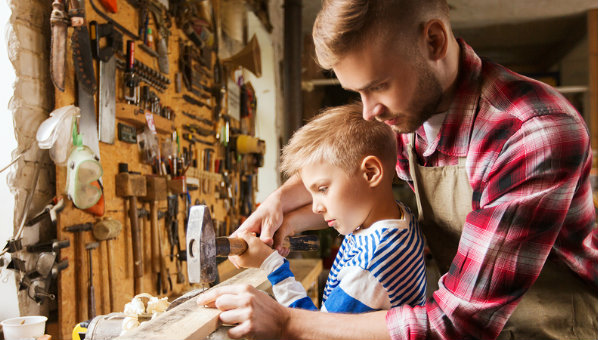Kids develop STEM habits in the classroom, but they spend most of their time outside of school. That’s where parents and other adults can help to inspire, support, and continue their children’s STEM learning.
That means that parents must also know what STEM is and have a toolkit of ideas for helping their kids.

By ANNE JOLLY
Dear Parent:
Your children are curious and constantly ask questions. They keenly observe the world around them and are learning to connect ideas. They draw, take things apart, build, and astutely observe others’ behaviors. They like to experiment and try new things.
In a nutshell, children are great natural learners. Children begin life “STEM-ready.”
You have regular opportunities to interact with your children, and studies indicate that your involvement can boost their STEM learning. And you don’t need to be an engineer, doctor, or scientist to do this.
First, let’s nail down what we mean by STEM.
STEM stands for science, technology, engineering, and math. Just as important: STEM is about learning how to solve problems, be creative and innovative, think logically, and understand the world a bit better. These are valuable skills and habits of mind for kids to acquire, no matter what they do in life. Helping them to acquire these skills can pay big dividends.

1. Talk with your child about STEM topics.
For example, talk about gravity when your child tosses a ball in the air. Discuss fractions or percent when you slice a pie. Cooking provides opportunities to talk about measurement, boiling and evaporation. Toys and vehicles give kids a chance to learn about pulleys, levers, and engines. When shopping, reinforce ideas about numbers, calculations, estimating, and so on. (Warning! Depending on the topic, you may need to do some brush-up research.)
2. Encourage curiosity and questioning.
Display curiosity about things you see and show your own interest in learning. Your enthusiasm may be the greatest motivator for your child’s interest in STEM.
When your child asks a question, rather than giving an answer or a solution, urge him or her to research information and to come up with several possible solutions for a problem. Ask your child questions as well. Use open-ended questions (with no right or wrong answer.) For example: Why do you like that game (toy, car, phone app, etc.) so much? Who designed it? Do you think the design can be improved? What would you do to improve the design? Use questions to inspire further conversations.
3. Encourage your child to think like an engineer.
Help kids understand that there are usually many solutions to a problem. They can be creative and collaborative (work with others) when looking for solutions. They can create models of their solutions, try them out, and then improve on these models. Like an engineer, your child can identify problems, attempt to find solutions, try out the solution to see if it works, and improve on it.
4. Use TV, computers, and other technologies to support STEM thinking.
View science and technology TV and videos with your child and talk together about the program afterward. Check out Bayer’s 2-minute videos on Making Science Make Sense. Go to BayerUS Your child will love these websites for creative STEM fun and information:
Design Squad – This PBS site features creative activities, engaging video, interactive games, and exciting contests.
Discover Engineering – At this site children can view videos, play interactive games, and design “Cool Stuff.”
TED-Ed lessons Worth Sharing provides short videos your child can choose from.
5. Make your home a STEM-friendly place.
Let your home reflect your kids’ interests. Does your child love to assemble things? Go with it. Playing with blocks and Legos is associated with later competence in math and problem-solving skills. Got a nature lover? Set up some outdoor learning opportunities for your child to explore.
Be enthusiastic about ideas that your child wants to test (within reason). Set up a place for experimenting and building models. Provide a variety of materials and tools that children can access safely. These don’t have to be expensive. Materials might include things like paper cups, craft sticks, glue, etc.

6. Search out STEM-related recreational outings such as a trip to a local science museum or an Exploreum.
Visit robotics competitions or maker faires and encourage your child to ask questions and participate. Look for camps and programs that will teach your child something new — mathletes, STEM camps, science activities — that he or she wouldn’t get in school.
7. Promote cooperation and teamwork.
Invite kids to work together on a STEM challenge. You might suggest kids form a STEM Invention Club. Before they begin, ask them to share some behaviors they value in other team members. Based on those values, help them develop some behavioral guidelines they will follow. Then guide kids in exploring and experimenting together, and gently remind them of their guidelines when necessary.
8. Help with STEM activities at school.
Stay in touch with your teacher for information on how and when to do this. Also enlist ideas with STEM activities at your home.
9. Start exploring careers.
Another way to encourage STEM exploration is to help your children visualize themselves in a rewarding career. Rapid changes in industry are creating new types of jobs that require the STEM skills you can help them develop.
At its heart, STEM is about solving real-world problems. The world is going to need more and more workers with the skills to identify problems, visualize and create innovative solutions, and constantly improve on those solutions. Encourage your children. Challenge them. Involve them in thinking like engineers.
And be sure to include your girls! They have as much grit, determination, and smarts as your boys. Your children can be among those who change the world for the better.

Want to discover more about STEM?
Check our products and boost your students' STEM skills in a fun and engaging way with robots! just a click away!

This article is original from Middle Web : https://www.middleweb.com/37512/ideas-for-parents-to-support-stem-habits/


